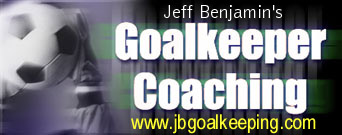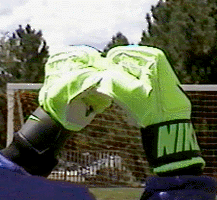
|
"Outstanding keeper instruction. This is a must for goalkeepers and coaches." — Ottawa Internationals S.C. web site, Ottawa, Canada |

|

|
|
|
Top |
Next: Breakaways
|
Be prepared to move [other players] by your determined run and jump, and always be aggressive. Polite goalkeepers may be nice to know, but they don't win matches!
-- Alan Wade, Coach Yourself Soccer
There are a few occasions when a goalkeeper will not be able to catch the soccer ball. It still must be kept out of the net, of course, so sometimes the keeper must deflect the ball over the crossbar or around the post. For high crossed balls in traffic, sometimes the safest play is to knock the ball way from the goal area if it cannot be caught. These are more advanced techniques, and often not as useful for very young keepers (particularly parrying shots over the bar, where a small keeper is as likely to just push the ball into the top of the net).
A ball may be too far away to catch cleanly, but sometimes just a fingertip to the ball can be enough to send it high or wide. Parrying, or tipping, is the technique used to do this.
![]() The open hand
(heel of the palm or fingertips, depending on the save)
should be used to redirect the ball, not the fist. Extended fingers
have a few more inches of reach than the fist in addition to having more
control.
The open hand
(heel of the palm or fingertips, depending on the save)
should be used to redirect the ball, not the fist. Extended fingers
have a few more inches of reach than the fist in addition to having more
control. ![]() Don't let your players
try to punch the ball around the goal - punching is reserved for crossed
balls and is discussed separately below.
Don't let your players
try to punch the ball around the goal - punching is reserved for crossed
balls and is discussed separately below.
Parrying High Balls
![]()
![]() The most
common use of parrying is to get to balls chipped over the
goalkeeper's head. The technique is very similar to how a baseball
fielder might play a similar ball hit over them. The basic steps are
these:
The most
common use of parrying is to get to balls chipped over the
goalkeeper's head. The technique is very similar to how a baseball
fielder might play a similar ball hit over them. The basic steps are
these:
- Decide (quickly!) which side the ball is going to. If it's coming directly at the keeper, they should just pick their most comfortable side.
- Get the hips pointed in the proper direction - turn left if going back to the left, turn right if going back to the right. This can also be accomplished by simply taking one step back with the foot on that side.
- Use a crossover step to get back as quickly as possible.
- Power step upwards, slightly backwards (the only time a keeper will ever be allowed to go backwards!) and through the ball. The keeper should aim to get to the ball as high as possible - above the level of the crossbar if they can.
- Get the opposite side hand to the ball. If the ball is on the left,
for example, the keeper should use the right hand. This is because
as the keeper turns sideways,
 the opposite hand becomes
the "top" hand and will be closest to the soccer ball.
the opposite hand becomes
the "top" hand and will be closest to the soccer ball.
- Use the fingers and top of the palm to simply direct the ball straight up. The momentum of the
ball will provide enough energy to get over the bar.
 The ball should not need to be
pushed up over the bar - if it's coming slowly enough to require a good push,
it should probably be caught instead of parried.
In addition, the palm should always face forward -
The ball should not need to be
pushed up over the bar - if it's coming slowly enough to require a good push,
it should probably be caught instead of parried.
In addition, the palm should always face forward -
 the keeper
should not turn the palm towards the goal and try to push or "dunk" the ball
backwards over the crossbar.
the keeper
should not turn the palm towards the goal and try to push or "dunk" the ball
backwards over the crossbar.
- Don't worry too much about the landing. Some keepers like to use their twisting momentum to roll out of the landing; others just land however they fall.
Good footwork, from hip turn to crossover to power step, is critical
to a good parry over the crossbar. ![]() A keeper should never back straight up on a ball over their head -
it puts their weight on their heels and can lead to balls pushed into the
top of the net, or worse yet, a bruised tailbone as they fall over
backwards.
A keeper should never back straight up on a ball over their head -
it puts their weight on their heels and can lead to balls pushed into the
top of the net, or worse yet, a bruised tailbone as they fall over
backwards.
Parrying Balls Around the Post
The technique for tipping balls around the post is similar to that for extension diving, except only one hand is used. Which hand? The closest to the ball. For low balls, this will be the one on the ball side, or the bottom hand once the keeper dives. For high balls, the hand on the far side should be used, as this will be the top hand when the keeper is horizontal.
To parry a ball around the goalpost:
- Use good footwork to get into position for the dive
- Explode through the ball, forward at an angle, using extension diving technique
- Lead with the hand closest to the ball, using the heel of the palm to deflect the ball outside the post. The heel of the palm provides the most solid surface to contact the ball while still maintaining some control.
![]() Make sure the keeper goes
forward at an angle when parrying around the post - the ball will not
be caught, so a goalkeeper diving backwards will all too often just
deflect the ball into the side netting.
Make sure the keeper goes
forward at an angle when parrying around the post - the ball will not
be caught, so a goalkeeper diving backwards will all too often just
deflect the ball into the side netting.
Punching, or boxing, is used to clear away crossed balls that cannot be caught, usually in heavy traffic. It is not a technique used often, as the ball should be caught whenever possible, but can be very effective in allowing a keeper to demonstrate they have complete control over their goal area. If there is any doubt for a keeper that they they will not be able to catch a cross, it should be punched. "When in doubt, punch it out" (but remember this applies only to crosses, not shots!).
 Punching hand position |
- Width - getting the ball towards the sidelines, out of the center of the soccer field
- Distance - getting the ball as far away from the goal as possible
- Height - getting the ball over the attacking players
The proper hand position for punching is important for best control and
for avoiding finger injuries. The hands should form a fist, with the
![]() four fingers forming a flat surface, and the thumb pressed firmly
against the side of the fist but below the flat surface out of harm's
way. The flat surface allows for the most control, as well as getting
sensitive knuckles out of the way.
four fingers forming a flat surface, and the thumb pressed firmly
against the side of the fist but below the flat surface out of harm's
way. The flat surface allows for the most control, as well as getting
sensitive knuckles out of the way.
![]() Do not tuck the thumb
inside the fingers, as this is just asking for a hand injury.
Do not tuck the thumb
inside the fingers, as this is just asking for a hand injury.
Punching can be done with one hand or both hands. This is determined by
the direction you want the ball to go:
![]() If you are trying to send the
ball back in the direction it is coming from, use two hands. If you
want the ball to continue away in the same direction it is already
going, use a one-handed punch.
If you are trying to send the
ball back in the direction it is coming from, use two hands. If you
want the ball to continue away in the same direction it is already
going, use a one-handed punch.
![]()
![]() A two-handed punch starts with the fists
placed together to form the largest surface possible. The hands should
start close to the body, elbows at the sides, and then explode through the ball,
utilizing back and hip muscles as well, to drive the ball high, far
and wide of the goal. Often a weak punch results when
A two-handed punch starts with the fists
placed together to form the largest surface possible. The hands should
start close to the body, elbows at the sides, and then explode through the ball,
utilizing back and hip muscles as well, to drive the ball high, far
and wide of the goal. Often a weak punch results when
![]() the ball is struck with arms already
extended, so make sure the hands start from close to the body.
the ball is struck with arms already
extended, so make sure the hands start from close to the body.
![]()
![]() The hand takes the same shape for a one-handed punch as for a two-handed
punch; use the flat surface formed by the fingers. Use a one handed
punch to box the ball in the same direction it is already going: use
the arm on the same side the ball is coming from, and punch in a
powerful, compact motion across the body to send the ball on.
The hand takes the same shape for a one-handed punch as for a two-handed
punch; use the flat surface formed by the fingers. Use a one handed
punch to box the ball in the same direction it is already going: use
the arm on the same side the ball is coming from, and punch in a
powerful, compact motion across the body to send the ball on.
![]() Avoid a wide,
looping swing as this does not generate much power. This should be a
punch, not a slap!
Avoid a wide,
looping swing as this does not generate much power. This should be a
punch, not a slap!
Quick Summary - Parrying: |
Mistakes to Watch For: |
|||||||||
|
|
|
|||||||||
Quick Summary - Punching: |
Mistakes to watch for: |
|||||||||
|
|
|
|
|
Top |
Next: Breakaways
|